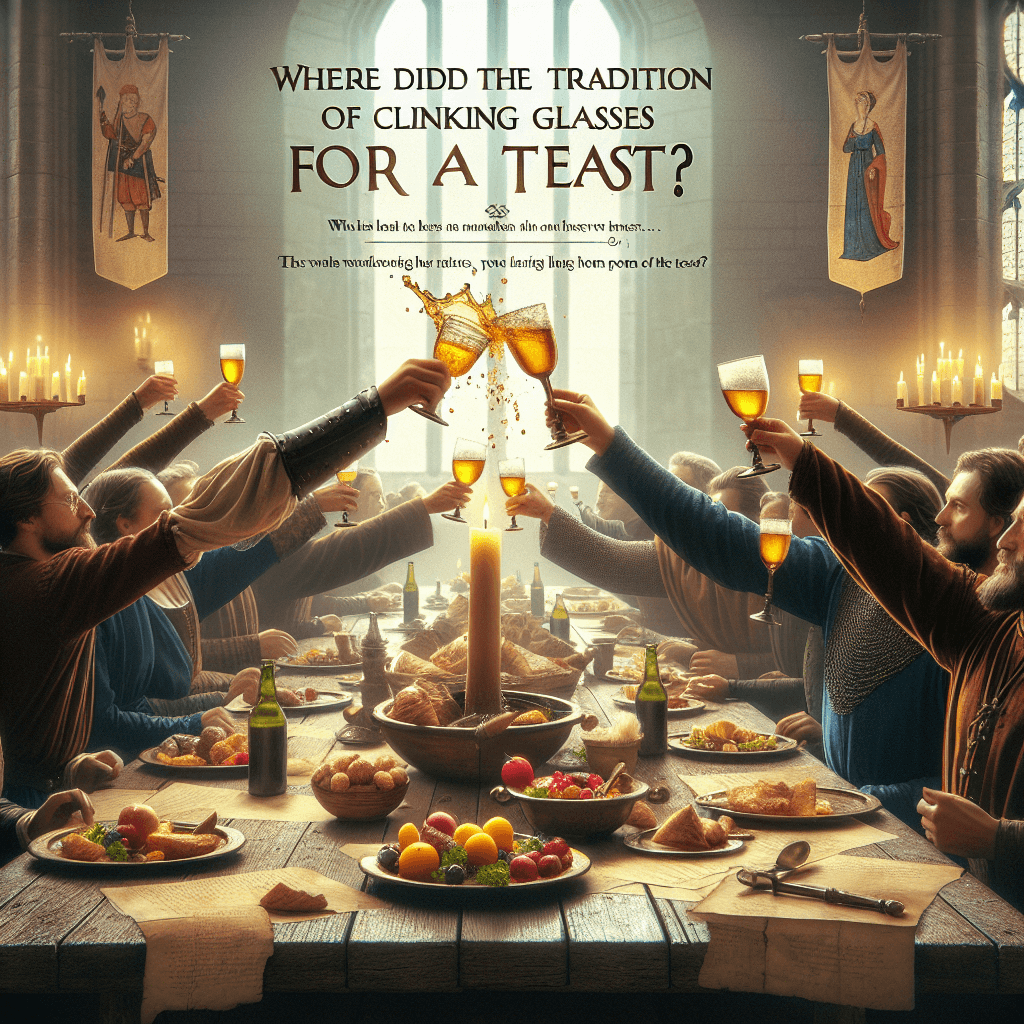Cheers! Where Did the Tradition of Clinking Glasses for a Toast Actually Come From
The clinking of glasses is a gesture so ingrained in our social fabric that we often do it without a second thought. But have you ever wondered about the historical origins of this celebratory tradition?


Too Long; Didn't Read
An exploration of the history and folklore behind the tradition of clinking glasses during a toast, from ancient superstitions to medieval precautions.
Cheers! Where Did the Tradition of Clinking Glasses for a Toast Actually Come From?
The sound is instantly recognizable at weddings, birthdays, and celebrations worldwide: the gentle clink of glasses meeting as a toast is proposed. It’s a gesture so ingrained in our social fabric that we often perform it without a second thought. But have you ever paused, mid-clink, and wondered why we do it? This seemingly simple act has a history shrouded in folklore, practicality, and maybe even a touch of paranoia. This post delves into the fascinating potential origins of clinking glasses, exploring the various theories that attempt to explain where this cherished tradition actually came from.
Uncorking the Theories: Potential Origins of the Clink
While no single origin story is universally accepted as historical fact, several compelling theories offer plausible explanations for why we touch our glasses together when raising a toast.
Theory 1: Warding Off Evil Spirits
One of the most popular and enduring theories dates back to medieval times, an era rife with superstition. It was believed that celebrations and joyous occasions might attract unwelcome attention from evil spirits or demons, drawn to the sounds of merriment.
- The Belief: Loud noises were thought to frighten away these malevolent entities.
- The Clink: The bell-like sound produced by clinking glasses together, especially metal or sturdy glass goblets used historically, was considered potent enough to scare off any lurking spirits, ensuring the celebration remained pure and blessed. While charming, direct historical evidence linking clinking specifically to warding off spirits during toasts is sparse, but it aligns with common medieval beliefs about noise and protection.
Theory 2: The Anti-Poison Protocol
Another widely circulated theory, also often placed in medieval or Renaissance Europe, suggests a more pragmatic, albeit slightly paranoid, origin: preventing poisoning. In times of political intrigue and shifting alliances, poisoning was a genuine fear, especially among the nobility.
- The Method: The idea was that when glasses were clinked together vigorously, liquid would slosh from one cup into the others.
- The Trust: This exchange supposedly acted as a show of good faith. If your host was willing to potentially ingest some of your drink (and vice-versa), it implied neither beverage was poisoned. Clinking became a sign of trust and camaraderie, assuring everyone that the drinks were safe. However, historians often view this theory with skepticism, noting that the amount of liquid actually exchanged would be minimal and unlikely to be an effective deterrent or proof.
Theory 3: Engaging All the Senses
A more philosophical and perhaps more likely explanation relates to enhancing the sensory experience of drinking, particularly wine. The enjoyment of a good drink involves multiple senses:
- Sight: Admiring the colour and clarity.
- Smell: Appreciating the aroma or bouquet.
- Taste: Savouring the flavour profile.
- Touch: Feeling the temperature and texture of the glass.
The act of toasting already incorporated these. Clinking, according to this theory, was introduced to bring the final sense – hearing – into the ritual. The chime of glasses completed the sensory circuit, making the act of drinking and celebrating a more holistic and engaging experience for everyone involved.
Theory 4: Symbol of Communal Bonding
Some historians suggest the practice evolved from ancient traditions involving shared drinking vessels. In many cultures, drinking from a common cup signified unity, peace, and shared agreement. As individual drinking vessels became more common, the act of clinking glasses together symbolically recreated that sense of shared experience and communal goodwill. It served as a gesture reinforcing the bonds between the people partaking in the toast, wishing collective health and happiness.
From Folklore to Modern Custom
Regardless of which theory (or combination thereof) holds the most truth, the tradition of clinking glasses has clearly endured. It spread across Europe and subsequently the world, evolving from its potential roots in superstition, safety concerns, or sensory enhancement into the near-universal symbol of celebration and shared goodwill it is today. While the exact answer to "Where did the tradition of clinking glasses for a toast actually come from?" remains elusive, lost to the mists of time and folklore, its persistence speaks volumes.
Conclusion: A Resounding Gesture of Goodwill
The history behind clinking glasses is a fascinating blend of potential reasons, from warding off spirits and ensuring drinks weren't poisoned to enhancing sensory pleasure and symbolizing unity. While we may never know the definitive origin, the lack of certainty doesn't diminish the power of the gesture. Today, the clink serves as an auditory punctuation mark for moments of joy, congratulations, and remembrance. It’s a simple sound that resonates with shared happiness and collective well-wishing, a tradition that continues to connect us across tables and cultures. So, the next time you raise your glass, remember the rich tapestry of possibilities behind that satisfying clink – a sound that echoes centuries of celebration.


